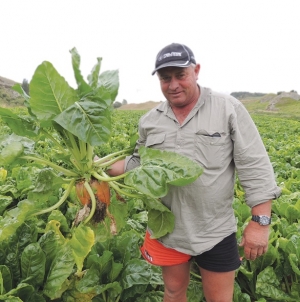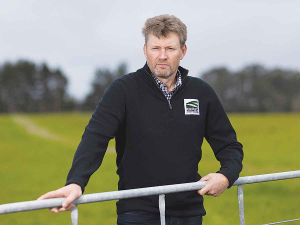So when South Canterbury dairy farmer Dave Ellis commented to machinery dealer Grant Wilkins how much a delay sowing his crops could cost him, Wilkins realised he might be able to help.
He went to see Ellis and told him they could supply him with a six-row Sola precision drill suitable for sowing fodder beet for less than $50,000.
What’s more, once the beet’s in, if he wanted to sow maize, or any other wide-row precision sown crop, the same drill would fit the bill.
Ellis quickly did the sums and even with the cost of hydraulic row-width setting and airfreight added it stacked up to buy one, rather than risk a long wait for an over-stretched contractor to reach him.
“With 300ha to do I would have paid the contractor as much as it cost to buy the drill,” he told Dairy News.
There was also the advantage of having control over your own destiny. “If we’re ready to go, we can go.”
When the drill arrived in mid-October his tractor drivers put it to work round the clock to get the crop in.
“It’s only a 3m drill so we went 24 hours a day to get the fodder beet in and get onto silaging. It took us about 10 days to get it all done.”
That included shifting the drill from Waimate, where Ellis has one of his four farms and has sown about 70ha, to Tara Hills in the lower Mackenzie Basin where he has another and has sown the balance of his winter fodder.
The remoteness of the Tara Hills crops – they’re over 100km inland from Waimate and in an area where there’s no local contractor equipped to sow beet – added to the argument for going drill-it-yourself (DIY), as did some stony paddocks which a contractor might have been reluctant to sow.
With irrigation he’s expecting yields of 25t/ha but has sown some extra area in case of a yield shortfall. Nonetheless, with 7000 cows to winter, it’s meant he’s been able to cut his winter crop area considerably compared to wintering on brassica.
Another advantage of the switch to beet is in the event of snow.
“We can be up against the elements at Tara Hills and if we do get snow we’ll only lose the leaf [off the beet] whereas kale can get completely flattened,” notes Ellis.
Wilkins, of Paul Wilkins Tractors, Timaru, says Ellis’ precision drill was one of three they imported last spring, another one having gone to a contractor and the third being kept as a demonstrator.
“We were importing their airseeder grain drills and grass drills anyway and the fodder beet area is ever increasing so we thought we’d look into importing their precision planters as well.”
While Wilkins sells another brand of precision planter in addition to the Sola, there’s a greater range available with the Solas and, as the importer, they’re able to offer them at a price that is “farmer friendly,” as Wilkins puts it.
He also likes the way they’re made, which is probably a reflection on the conditions in the country of origin, Spain, he suggests.
“They’re heavily built so they’re going to cope with New Zealand’s stones and lumpy ground. They’ll go up and down all day. I expect it’s because the Spanish have stoney conditions similar to us.”
Powder coated paintwork is to a high standard and all parts are reasonably easy to replace.
In the “worst case scenario” of a seeder stopping working, it can be switched to the outside position on the drill so work can continue at a narrower operating width until the problem is fixed, points out Wilkins.
“We have a complete seeder unit here in the showroom which we could send out in a real emergency because they’re all the same. The rest of the machine is just a big frame really.”
There is some clever componentry, such as a sensor and alarm, so if a seeder malfunctions there’s no risk of the operator pushing on for hectare after hectare with a row missing.
The cheapest models have seeders bolted onto the main beam so changing drilling width takes time with spanners and sockets in hand, but all three machines Wilkins’ has imported have the vari-width feature which allows operators to change row-width hydraulically.
“Most people are using 50cm rows but some are using 45cm.”
It also means the 6-row model is easily reduced to 3m for road transport, avoiding the extra expense of folding/stacking mechanisms for outer rows.
“They don’t take up too much space in a shipping container either, which also helps keep the cost down,” notes Wilkins.
If a drill does need to go on a truck for whatever reason, there are easily accessible and robust lift hooks on the main beam so there’s no need to put pallet forks under the machine and risk breaking or bending seeders, he adds.
The seeders themselves use a pto-driven vacuum to suck seed onto a rotating disc which places the seed in the furrow between the two opening discs. A narrow press wheel follows, closing the furrow and ensuring good seed to soil contact.
While the vacuum is pto-driven, the standard seeder drive is hydraulic. A pto-drive option is available but would only be needed if the machine were to be used on an older tractor with poor hydraulics, says Wilkins.
The gearbox is easily adjusted with two leavers, and extra discs to increase the range of in-row spacing options come in at less than a $100 each, though if sowing maize and fodder beet is all that’s going to be done, it’s unlikely more than one disc will be needed.
In the paddock each seeder’s 55L hopper will hold more than enough beet seed for a day’s work, says Wilkins. “A litre box holds 80,000 seeds and most people are sowing at 80-90,000 seeds/ha.”
Operating speed can be up to 12-13kmh depending on ground condition.
















